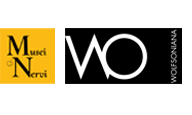TICKETS
Until 31 December 2025
Individual Ticket – Wolfsoniana
Full price: €5
Reduced: €3
Special reduced price: €2 for visitors aged 18 to 25
From 2 January 2026
Combined Ticket – Nervi Museums
From Tuesday to Thursday: reduced admission
Friday, Saturday and Sunday: full admission
Full price: €14
Reduced: €9
Special reduced price: €2 for visitors aged 18 to 25
Who is entitled to a reduced ticket
Who can enter for free
In the case of special events or temporary exhibitions, ticket prices may vary.
Booking online (presale 1 €).
For complaints and returns download this form
In case of impossibility to visit the museum, you can request a refund of the entrance tickets (single, full or reduced, cards), including those purchased online. The refund request must be submitted within 15 days of the outage using this form.
Ticketone Sales Points
Tabaccheria 248 - Via Simone Pacoret de Saint Bon 1/R 16155 Genova
Reina Jesus Mendoza Ruiz - Planetwin365 – PlanetPay Piazza Sciesa 45 R 16157 Genova
Tabaccheria Giarelli - Via Paolo Giacometti 58/60 R 16143 Genova
Tabaccheria Tredici Bis di Galli Fabrizio - Piazzale Parenzo 23/R 16139 Genova
Wolfsonian Museum
The Wolfsonian Museum is part of a group of Museums in Nervi together with the GAM Modern Art Museum, the Giannettino Luxoro Museum and the Frugone Collections.
The collection, created by the American philanthropist Mitchell “Micky” Wolfson Jr. and donated by him to the city of Genoa through the Palazzo Ducale Foundation for Culture, focuses in particular on the decorative and propaganda arts of the period 1880-1945.
Starting from the taste for the exotic which spread in Italy during the nineteenth century, the exhibition encompasses the major linguistic and expressive currents of the first fifty years of the twentieth century, from Liberty to Déco, from the twentieth century to Rationalism, to offer the visitor a panorama of the period between the last decades of the nineteenth century and the first half of the twentieth, in which the artistic expressions interacted closely with the political, social, economic, technological and aesthetic context in which they saw the light.
Thanks to the vast variety of artefacts preserved - paintings, sculptures, furniture, glass, ceramics, metals, fabrics, architectural drawings and designs, posters, sketches, graphics, books, magazines and documents - mainly related to the Italian context but with significant evidence of the foreign influence, the Wolfsonian collection documents, faithful to the approach of its creator, not only the aesthetic values of the objects it contains, but also the profound historical and social significance of the time.
The museum is characterized by its chronological-thematic layout, which involves the reconstruction of entire rooms, it also has an area dedicated to temporary exhibitions.
Top Ten
The Wolfsonian Museum is something unique in the rich panorama of Italian museums. First of all, for the figure of the collector who with passion and curiosity formed this important artistic collection over the years, encouraging, at the same time, an institution which was to be entrusted with its conservation, study and growth. Secondly, for the originality of the collection which, consisting of a wide range of materials - paintings, sculptures, furniture, complete furnishings, glass, ceramics, wrought iron, silver, fabrics, architectural drawings, graphics, posters and advertising materials , sketches and drawings, books and magazines - focuses mainly on the decorative and propaganda arts from 1880 to 1945.
However, the collection is not limited to identifying the aesthetic values of the objects, but above all focuses on the historical and social meanings that they convey. In fact, each piece of this collection contributes to recomposing, in a dense network of historical and artistic references and counterpoints, the complexity of a historical period that has marked the birth and evolution of the contemporary era. All the works contribute to analysing those factors of change that characterized this dense historical period: the profound links between art and politics; the dialectic between avant-garde impulses and references to tradition; changes in taste in the field of furniture; the contribution of new materials and new technologies in the evolution of design; the impact on the society of the time by new means of transport; the sophisticated use of persuasive messages in advertising; the interaction between the great urban transformations and the formation of a new industrial civilization.







Follow us on Facebook
Follow us on Tripadvisor